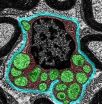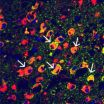(Press-News.org) Anyone whose hand or foot has "fallen asleep" has an idea of the numbness and tingling often experienced by people with peripheral nerve damage. The condition also can cause a range of other symptoms, including unrelenting pain, stinging, burning, itching and sensitivity to touch.
Although peripheral neuropathies afflict some 20 million Americans, their underlying causes are not completely understood. Much research has focused on the breakdown of cellular energy factories in nerve cells as a contributing factor.
Now, new research at Washington University School of Medicine in St. Louis points to a more central role in damage to energy factories in other cells: Schwann cells, which grow alongside neurons and enable nerve signals to travel from the spinal cord to the tips of the fingers and toes.
The finding may lead to new therapeutic strategies to more effectively treat symptoms of this highly variable disorder, the scientists report March 6 in the journal Neuron.
"We found that a toxic substance builds up in Schwann cells that have disabled energy factories, leading to the same kind of nerve damage seen in patients with neuropathies," says senior author Jeffrey Milbrandt, MD, PhD, the James S. McDonnell Professor of Genetics and head of the Department of Genetics. "Now, we're evaluating whether drugs can block the buildup of that toxin, which could lead to a new treatment for the condition."
The most common cause of peripheral neuropathy is diabetes, which accounts for about half of all cases. The condition also can occur in cancer patients treated with chemotherapy, which can damage nerves.
In the body, Schwann cells wrap tightly around nerve axons, the fibers that relay nerve signals. Graduate student and first author Andreu Viader and colleagues in Milbrandt's lab studied Schwann cells in mice with genetically disabled mitochondria, or cellular energy factories. Under normal conditions, these mitochondria produce fuel and intermediates of energy metabolism that allow nerve cells to function.
The researchers showed that the crippled mitochondria activated a stress response in the Schwann cells. Instead of synthesizing fatty acids, a key component of Schwann cells, the cells burned fatty acids for fuel.
Over time, inefficient burning of fatty acids by the crippled mitochondria leads to a build up of acylcarnitines, a toxic substance, in the Schwann cells. The researchers found levels of acylcarnitines up to 100-fold higher in these mutant Schwann cells than in healthy Schwann cells.
And the bad news doesn't end there. Eventually, the toxin leaks out of the Schwann cells and onto the nerve axons. Studying neurons in petri dishes, the researchers showed that acylcarnitines damage nerve axons and disrupt the ability of nerves to relay signals.
"The toxin leaking out of the Schwann cells and onto the adjacent nerve axons causes damage that results in pain, numbness, tingling and other symptoms," Milbrandt says. "We think that is a likely mechanism to explain the degeneration of axons that is known to occur in peripheral neuropathies."
The new research suggests that drugs that inhibit the buildup of acylcarnitines may block axonal degeneration. Milbrandt and his team now are evaluating the drugs in mice with disabled Schwann cells to see if they can slow or alleviate the decay of axons.
INFORMATION:
The research is supported by the National Institutes of Health (NIH) Neuroscience Blueprint Center Core Grant (P30 NS057105), the HOPE Center for Neurological Disorders, National Institutes of Health Grant AG13730 and PPG 2P01 HL057278.
Viader A, Sasaki Y, Kim S, Strickland A, Workman CS, Yang K, Cross RW, Milbrandt J. Aberrant Schwann cell lipid metabolism linked to mitochondrial deficits leads to axon degeneration and neuropathy. Neuron. March 6, 2103.
Washington University School of Medicine's 2,100 employed and volunteer faculty physicians also are the medical staff of Barnes-Jewish and St. Louis Children's hospitals. The School of Medicine is one of the leading medical research, teaching and patient care institutions in the nation, currently ranked sixth in the nation by U.S. News & World Report. Through its affiliations with Barnes-Jewish and St. Louis Children's hospitals, the School of Medicine is linked to BJC HealthCare.
New clues to causes of peripheral nerve damage
2013-03-07
ELSE PRESS RELEASES FROM THIS DATE:
Improving electronics by solving nearly century-old problem
2013-03-07
RIVERSIDE, Calif. (http://www.ucr.edu) — A University of California, Riverside Bourns College of Engineering professor and a team of researchers published a paper today that shows how they solved an almost century-old problem that could further help downscale the size of electronic devices.
The work, led by Alexander A. Balandin, a professor of electrical engineering at UC Riverside, focused on the low-frequency electronic 1/f noise, also known as pink noise and flicker noise. It is a signal or process with a power spectral density inversely proportional to the frequency. ...
Some brain cells are better virus fighters
2013-03-07
Viruses often spread through the brain in patchwork patterns, infecting some cells but missing others. New research at Washington University School of Medicine in St. Louis helps explain why. The scientists showed that natural immune defenses that resist viral infection are turned on in some brain cells but switched off in others.
"The cells that a pathogen infects can be a major determinant of the seriousness of brain infections," says senior author Michael Diamond, MD, PhD, professor of medicine. "To understand the basis of disease, it is important to understand which ...
Breaking the rules for how tsunamis work
2013-03-07
The earthquake zones off of certain coasts—like those of Japan and Java—make them especially vulnerable to tsunamis, according to a new study. They can produce a focusing point that creates massive and devastating tsunamis that break the rules for how scientists used to think tsunamis work.
Until now, it was largely believed that the maximum tsunami height onshore could not exceed the depth of the seafloor. But new research shows that when focusing occurs, that scaling relationship breaks down and flooding can be up to 50 percent deeper with waves that do not lose height ...
Scientists improve transgenic 'Enviropigs'
2013-03-07
A research team at the University of Guelph has developed a new line of transgenic "Enviropigs." The new line of pigs is called the Cassie line, and it is known for passing genes on more reliably. The results of this project were published ahead of print in the Journal of Animal Science.
Enviropigs have genetically modified salivary glands, which help them digest phosphorus in feedstuffs and reduce phosphorus pollution in the environment. After developing the initial line of Enviropigs, researchers found that the line had certain genes that could be unstable during reproduction ...
Study finds risk of brain damage in college football players, even among those without concussions
2013-03-07
Wednesday, March 6, 2013, Cleveland: Concussions are the leading cause of brain damage in sports, particularly in football. However, researchers at Cleveland Clinic and the University of Rochester have found that football players may suffer long-term brain changes even in the absence of concussion.
In a study of 67 college football players, researchers found that the more hits to the head a player absorbed, the higher the levels of a particular brain protein that's known to leak into the bloodstream after a head injury. Even though none of the football players in the ...
Scientists at A*STAR's Genome Institute of Singapore catch evolving germs and cancer cells early
2013-03-07
Scientists at A*STAR's Genome Institute of Singapore (GIS) have developed a novel technique to precisely monitor and study the evolution of micro-organisms such as viruses and bacteria. This is an extremely important capability as it allows scientists to investigate if new drugs designed to kill them are working, and catch the development of resistance early on.
Micro-organisms and cancer cells evolve more quickly than normal human cells as their rapid life-cycles enable faster selection of advantageous mutations. Previously, scientists have had to wait for the selection ...
Fatty acids could lead to flu drug
2013-03-07
Flu viruses are a major cause of death and sickness around the world, and antiviral drugs currently do not protect the most seriously ill patients. A study published March 7th by Cell Press in the journal Cell reveals that a compound derived from fats found in fish oils prevents death in influenza-virus-infected mice, even at advanced stages of disease. The study offers a promising strategy for the treatment of patients with severe influenza virus infections.
"Given the potential for future lethal pandemics, effective drugs are needed for the treatment of severe influenza, ...
Sniff, sniff. What did you say?
2013-03-07
When animals like dogs or rats sniff one another, there might be more going on than you'd think. Research reported in Current Biology, a Cell Press publication, on March 7th finds in rats that those sniffing behaviors communicate information about an individual's social status. In those encounters, more dominant rats act as primary sniffers, while subordinate sniffees actually slow their breath.
"We know that rats and other animals can communicate through vocalizations, physical contact, odors, and also visual displays," says Daniel Wesson of Case Western Reserve University. ...
When food is scarce, a smaller brain will do
2013-03-07
A new study explains how young brains are protected when nutrition is poor. The findings, published on March 7th in Cell Reports, a Cell Press publication, reveal a coping strategy for producing a fully functional, if smaller, brain. The discovery, which was made in larval flies, shows the brain as an incredibly adaptable organ and may have implications for understanding the developing human brain as well, the researchers say.
The key is a carefully timed developmental system that ultimately ensures neural diversity at the expense of neural numbers.
"In essence, this ...
Using human brain cells to make mice smarter
2013-03-07
VIDEO:
What happens when human brain cells that surround and support neurons are implanted into the brains of newborn mice? Researchers reporting in the March 7th issue of the Cell Press...
Click here for more information.
What happens when human brain cells that surround and support neurons are implanted into the brains of newborn mice? Researchers reporting in the March 7th issue of the Cell Press journal Cell Stem Cell recently found that such mice had enhanced learning and ...


